| |

| Author |
Topic Options
|

 Posts:
Posts: 13404
 Posted: Posted: Fri Nov 14, 2014 6:20 pm
ShepherdsDog ShepherdsDog: They should have used Energizer It was probably wired by the British.
|

 Posts:
Posts: 51957
 Posted: Posted: Tue Nov 18, 2014 7:36 am
Some amazing images in the last few days: http://www.esa.int/spaceinimages/Images/2014/11Say goodbye to Philae! 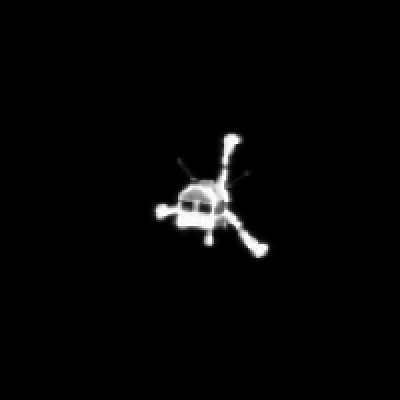 Watch it bounce: 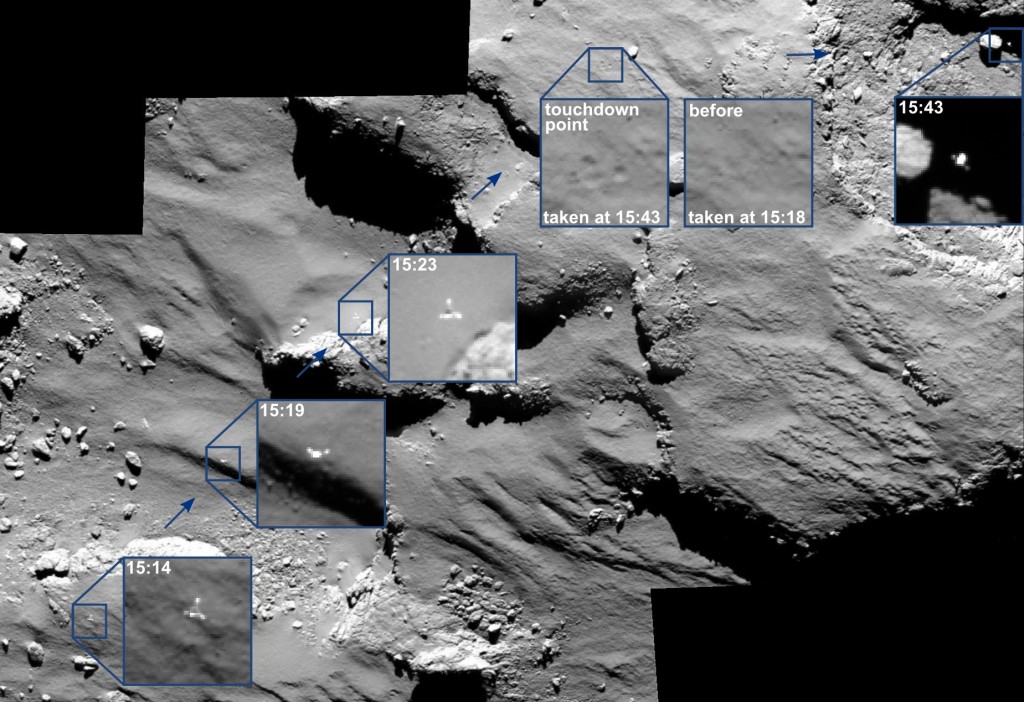 $1: These incredible images show the breathtaking journey of Rosetta’s Philae lander as it approached and then rebounded from its first touchdown on Comet 67P/Churyumov–Gerasimenko on 12 November 2014.
The mosaic comprises a series of images captured by Rosetta’s OSIRIS camera over a 30 minute period spanning the first touchdown. The time of each of image is marked on the corresponding insets and is in GMT. A comparison of the touchdown area shortly before and after first contact with the surface is also provided.
The images were taken with Rosetta’s OSIRIS narrow-angle camera when the spacecraft was 17.5 km from the comet centre, or roughly 15.5 km from the surface. They have a resolution of 28 cm/pixel and the enlarged insets are 17 x 17 m.
From left to right, the images show Philae descending towards and across the comet before touchdown. The image taken after touchdown, at 15:43 GMT, confirms that the lander was moving east, as first suggested by the data returned by the CONSERT experiment, and at a speed of about 0.5 m/s.
The final location of Philae is still not known, but after touching down and bouncing again at 17:25 GMT, it reached there at 17:32 GMT. The imaging team is confident that combining the CONSERT ranging data with OSIRIS and navcam images from the orbiter and images from near the surface and on it from Philae’s ROLIS and CIVA cameras will soon reveal the lander’s whereabouts. http://blogs.esa.int/rosetta/2014/11/17 ... the-comet/And, say hello to a comet, from Philae! 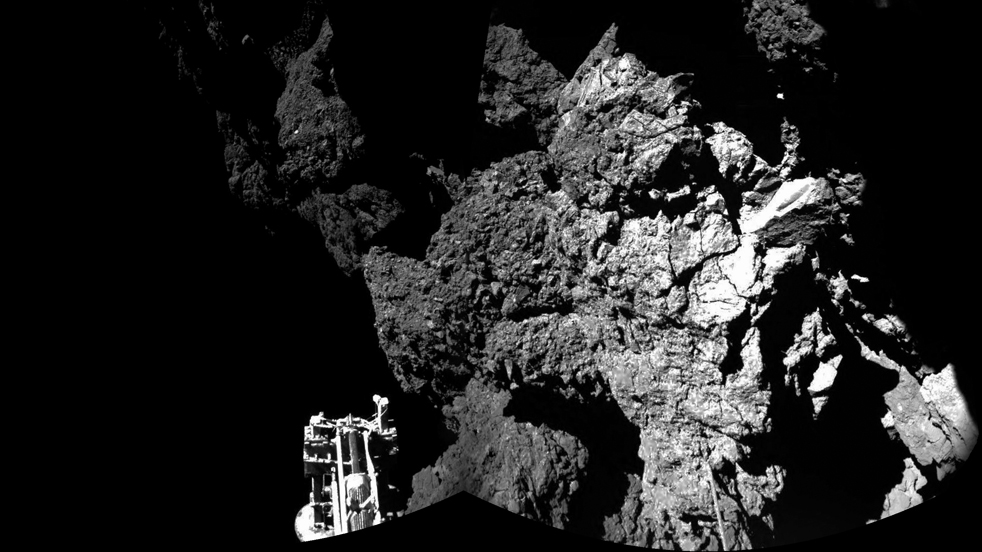 http://www.esa.int/spaceinimages/Images ... to_a_comet http://www.esa.int/spaceinimages/Images ... to_a_cometThe lander is down, but not out! Batteries are very low, but they will get a little charging from time to time, and more than likely will get longer and longer charges the closer it approaches the Sun this summer. The data it sent back will take years to go through! For those who like to download shows, there is a copy available of BBC's "The Sky at Night" special from ESA headquarters during the lander mission. Pretty awesome imagery there!
|

 Posts:
Posts: 51957
 Posted: Posted: Tue Nov 18, 2014 11:07 am
$1: Philae finds comet harbors organicsEurope’s Philae lander found a surface as hard as ice and organic molecules after it bounced to a stop on a comet last week. Scientists looking over the spoils from the plucky little Philae probe released some of the first results from the mission Monday after a hectic week of descent preparations, a dramatic landing that included three touchdowns, and more than 60 hours of data gathering. “We have collected a great deal of valuable data, which could only have been acquired through direct contact with the comet,” said Ekkehard Kuhrt, scientific director for the Philae mission at DLR — the German space agency. “Together with the measurements performed by the Rosetta orbiter, we are well on our way to achieving a greater understanding of comets. Their surface properties appear to be quite different than was previously thought.” After coming to rest on its side, Philae continued transmitting data intermittently when in range of Rosetta, the European-built orbiter that deployed the refrigerator-sized lander for its descent Wednesday. Rosetta continues flying around comet 67P/Churyumov-Gerasimenko, with at least another year of observations planned as the icy world moves toward the sun. It will heat up and give off more gas and dust through perihelion — its closest approach to the sun — in August 2015. Before its battery died, Philae unfurled an instrument boom to study the comet’s surface properties. The MUPUS instrument was designed to hammer into the nucleus about 1.5 meters (about 5 feet) from the lander, and data show the system worked as planned despite Philae’s precarious position lodged against a rocky face at an angle with one leg pointing into space. “Although the power of the hammer was gradually increased, we were not able to go deep into the surface,” said Tilman Spohn, head of the MUPUS instrument on Philae. “We have acquired a wealth of data, which we must now analyze.” According to a DLR press release, the MUPUS team estimates the outer skin of the comet’s nucleus — at least where Philae settled after its bouncy landing — is as hard as ice. 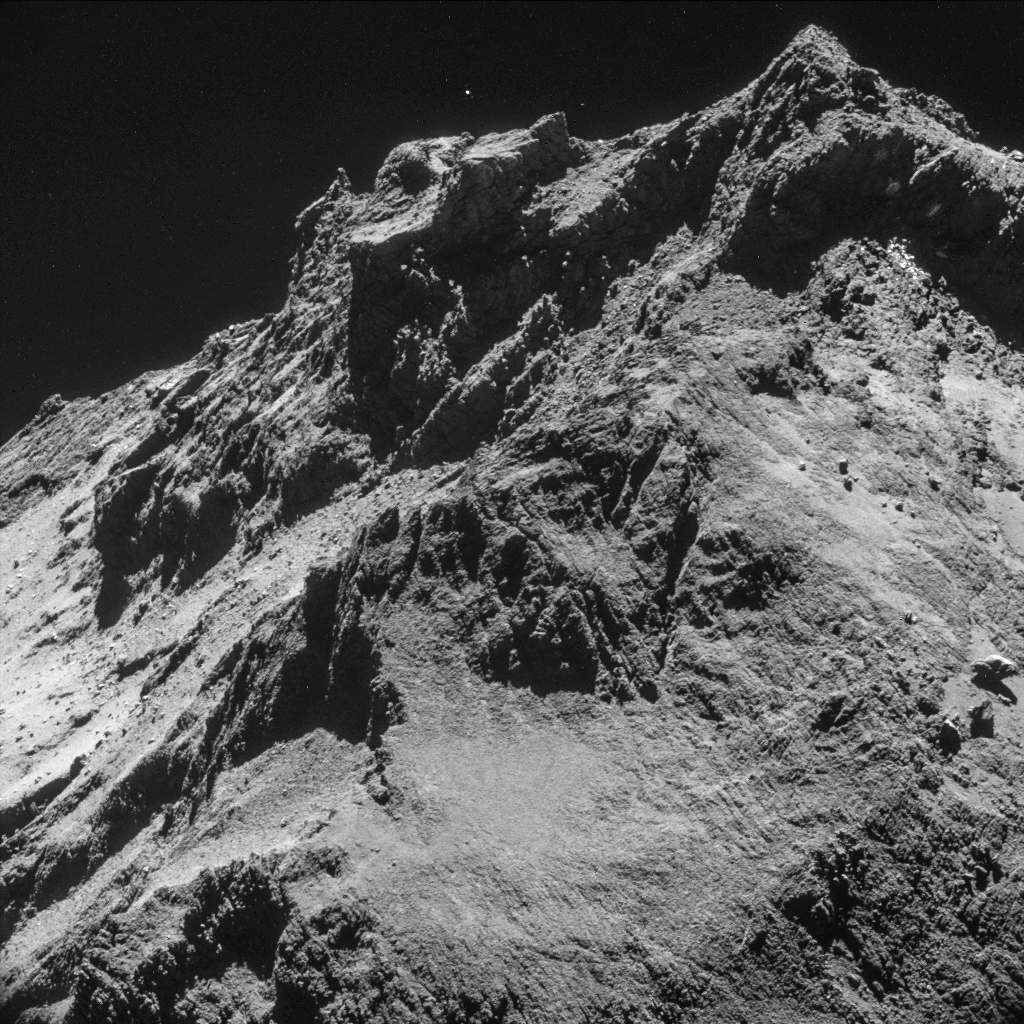 http://spaceflightnow.com/2014/11/18/ph ... -organics/
|

 Posts:
Posts: 51957
 Posted: Posted: Tue Nov 18, 2014 11:49 am
$1: First observations of the surfaces of objects from the Oort CloudThe results are particularly intriguing because the surfaces are different from what astronomers expected, and they give us clues about the movement of material in the early solar system as the planets were assembled. Astronomers have discovered two unusual objects in comet-like orbits that originate in the Oort Cloud but with almost no activity, giving scientists a first look at their surfaces. These results are particularly intriguing because the surfaces are different from what astronomers expected, and they give clues about the movement of material in the early solar system as the planets were assembled. On August 4, 2013, an apparently asteroidal object, C/2013 P2 (Pan-STARRS), was discovered by the Pan-STARRS1 survey telescope (PS1) on Haleakala, Maui, Hawaii. What made this object unique is its orbit — that of a comet coming from the Oort Cloud, with an orbital period greater than 51 million years, yet no cometary activity was seen. The Oort Cloud is a spherical halo of comet nuclei in the outer solar system that extends to about 100,000 times the Earth-Sun distance, or 100,000 astronomical units. "Objects on long-period orbits like this usually exhibit cometary tails, for example Comet ISON and Comet Hale-Bopp, so we immediately knew this object was unusual," said team leader Karen Meech from the University of Hawaii at Manoa. "I wondered if this could be the first evidence of movement of solar system building blocks from the inner solar system to the Oort Cloud." Follow-up observations in September 2013 with the 8-meter Gemini North Telescope on Mauna Kea, Hawaii, hinted at faint, low-level light reflected off a dusty tail. This tail remained through the object's closest approach to the Sun (2.8 times the Earth-Sun distance, within the outer asteroid belt) in February 2014, but the object didn't get much brighter. When the object was observable again in the spring, the team used the Gemini North Telescope to obtain a spectrum of the surface, which showed that it was red, completely different from comet or asteroid surfaces, and more like the surface of an ultra-red Kuiper Belt object. "We had never seen a naked (inactive) Oort Cloud comet, but Jan Oort hypothesized their existence back in 1950 when he inferred the existence of what we now call the Oort Cloud. Oort suggested that these bodies might have a layer of ‘volatile frosting’ left over from 4.5 billion years of space radiation that disappears after their first pass through the inner solar system. Maybe we are seeing the first evidence of this," said Olivier Hainaut of the European Southern Observatory.  http://www.astronomy.com/news/2014/11/f ... oort-cloud
|

 Posts:
Posts: 13404
 Posted: Posted: Tue Nov 18, 2014 6:35 pm
What do think that somewhere, sometime the comet might spin a bit an expose those solar panels to the sun, thus recharging the batteries. She could unexpectedly come back to life, somewhere in the future. Maybe, while closer to the sun ....
|

 Posts:
Posts: 51957
 Posted: Posted: Wed Nov 19, 2014 6:37 am
Jabberwalker Jabberwalker: What do think that somewhere, sometime the comet might spin a bit an expose those solar panels to the sun, thus recharging the batteries. She could unexpectedly come back to life, somewhere in the future. Maybe, while closer to the sun .... That was the gist of the article two posts back. As it approaches the sun, the odds are good that Philae will get more light. It's already accomplished the science it was sent to do, but they were hoping for more long term experiments.
|

 Posts:
Posts: 51957
 Posted: Posted: Wed Nov 19, 2014 12:01 pm
Tonight PBS will air the documentary "To Catch a Comet" where a film crew spent the last year with the ESA team and the Rosetta Mission.
|

 Posts:
Posts: 51957
 Posted: Posted: Thu Nov 20, 2014 7:15 am
$1: Milky Way's Monster Black Hole Ignores Its 'Snack,' and Debate Swirls Earlier this year, astronomers watched eagerly as a cloud of gas moved dangerously close to the colossal black hole at the heart of our Milky Way galaxy — like a wildebeest wandering toward a lion. Anticipation grew over whether or not part of the cloud would pass the point of no return and be pulled, helplessly, into that gaping black maw. The destruction of the gas cloud G2 by the Milky Way's supermassive black hole (which scientists call Sagittarius A*) was set to be one of the main events of the year for astronomy. "[It] was one of the most watched events in astronomy in my career," Andrea Ghez, an astrophysicist at UCLA, said in a statement. [Milky Way's Black Hole to Eat a Gas Cloud (Images)] But today, Ghez isn't convinced there will be a black hole feeding event, because she thinks the G2 gas cloud isn't a cloud at all. Instead, Ghez and her colleagues suspect the weird object is actually a hidden star. If that's the case, the star could safely pass around Sagittarius A* (pronounced "Sagittarius A-star," Sgr A* for short). As late as August, Ghez's team observed that G2 is still compact, suggesting that it is a tightly bound body. "G2 survived and continues happily on its orbit," Ghez said in a statement. "A gas cloud would not do that." Sounds like a survival story of cosmic proportions, right? But not so fast. It's rare, to say the least, for a star to exist inside a gas cloud so thick that astronomers can't see the star shine. "The central feature of a star, in some sense, is that you see the photosphere," said Stefan Gillessen, a researcher at the Max Planck Institute for Extraterrestrial Physics near Munich where astronomers first identified G2, says it is still possible that G2 is a pure gas cloud. The ball has been going back and forth like this for over a year. Ghez and her group feel that their most recent results close the case; but Gillessen holds that the gas cloud theory isn't done yet. While more data often adds clarity to a scientific mystery, the observations thus far have only deepened the puzzle of G2.  A computer simulation of the G2 gas cloud's encounter with the supermassive black hole Sagittarius A* at the center of the Milky Way. Credit: SO/MPE/Marc Schartmann 3 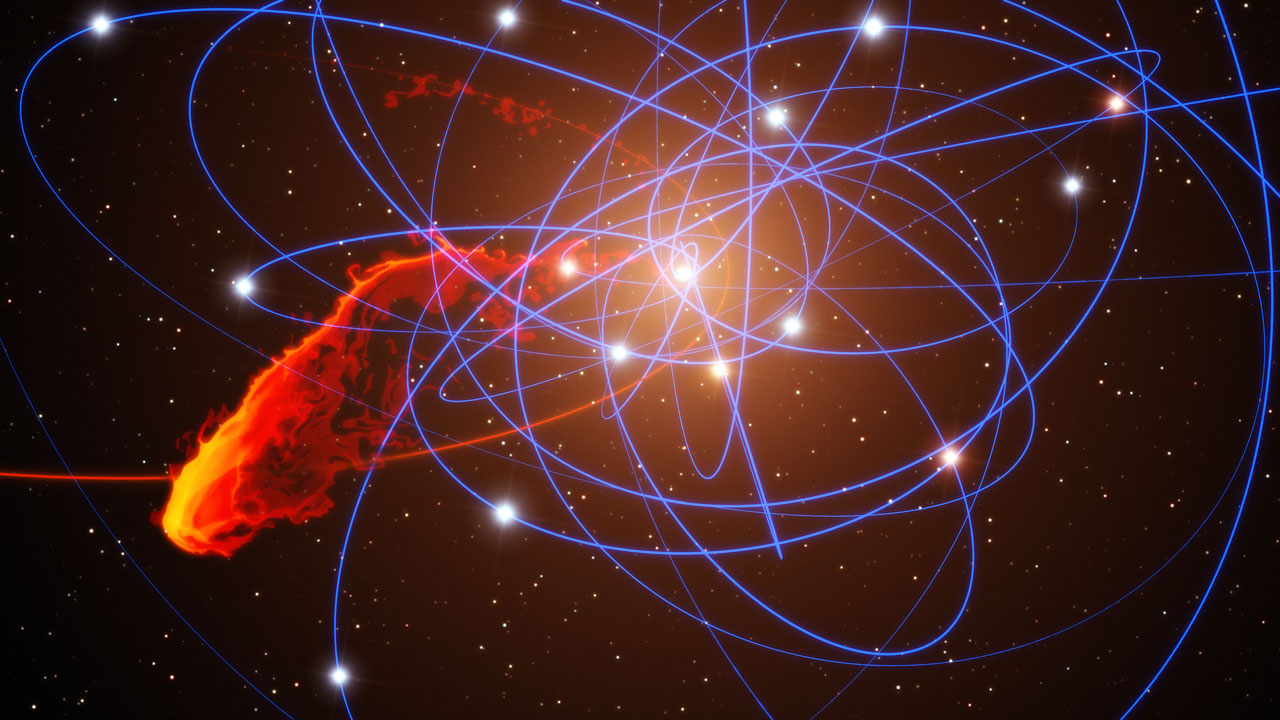 http://www.space.com/27811-milky-way-mo ... snack.html
|

 Posts:
Posts: 51957
 Posted: Posted: Thu Nov 20, 2014 7:17 am
$1: Andromeda Galaxy Glitters in Spectacular Photo by Astrophotographer
A huge number of stars shine brightly in an amazing skywatcher photo of the Andromeda Galaxy. André van der Hoeven, a photographer based in the Netherlands, captured the image. It took van der Hoeven about 9.6 hours to complete the new photo of Andromeda, which was reprocessed since it was initially taken in September. "The galaxy came out quite a lot better in this new image," van der Hoeven told Space.com of the reprocessed image. Scientists think that the Andromeda galaxy (also called M31) will eventually merge with the Milky Way in about 4 billion years from now. Andromeda is located about 2.5 million light-years from the Milky Way and it is the largest galaxy in the galactic group where they are located. The merging of the two galaxies will likely create one large, elliptical galaxy unlike the Milky Way's current spiral shape. Now is the time to see Andromeda in the night sky, according to Starry Night Education's Geoff Gaherty. Draw a line straight out from the right-hand part of the "W" of the constellation Cassiopeia and you should find M31 glowing like a faint-fuzzy splotch in the sky, Gaherty wrote in a November skywatching guide.  André van der Hoeven took this image of the Andromeda Galaxy in September 2014. Credit: André van der Hoeven http://www.space.com/27819-andromeda-ga ... photo.html
|

 Posts:
Posts: 51957
 Posted: Posted: Thu Nov 20, 2014 11:52 am
$1: Geologic maps of Vesta from the Dawn mission publishedScientists have discovered through these maps that impacts from several large meteorites have shaped the asteroid’s history. Images from NASA’s Dawn mission have been used to create a series of high-resolution geological maps of the large asteroid Vesta, revealing the variety of surface features in unprecedented detail. Geological mapping is a technique used to derive the geologic history of a planetary object from detailed analysis of surface morphology, topography, color, and brightness information. Mapping the surface of Vesta using Dawn spacecraft data was a team of 14 scientists led by three NASA-funded participating scientists: David A. Williams of Arizona State University, Tempe; R. Aileen Yingst of the Planetary Science Institute in Tucson, Arizona; and W. Brent Garry of the NASA Goddard Space Flight Center in Greenbelt, Maryland. “The geologic mapping campaign at Vesta took about two-and-a-half years to complete, and the resulting maps enabled us to recognize a geologic timescale of Vesta for comparison to other planets,” said Williams. Scientists discovered through these maps that impacts from several large meteorites have shaped Vesta’s history. Asteroids like Vesta are remnants of the formation of the solar system, giving scientists a peek at its history. Asteroids also could harbor molecules that are the building blocks of life and reveal clues about the origins of life on Earth.  http://www.astronomy.com/news/2014/11/g ... -publishedDawn left Vesta, and is more than halfway to the asteroid Ceres.
|

 Posts:
Posts: 51957
 Posted: Posted: Tue Nov 25, 2014 1:31 pm
$1: NASA Unveils Most Amazing View of Jupiter's Moon Europa Ever An incredible, reprocessed picture of Jupiter's moon Europa shows the mysterious natural satellite's amazing colors as they have never been seen before. The original photos of Europa were collected by the Galileo spacecraft, which explored Jupiter and its moons from orbit in the 1990s. NASA officials reprocessed Galileo's data using modern imaging techniques that improved on an enhanced-color view of Europa the agency created in 2001. The new photo, released on Nov. 21, shows the largest proportion of Europa's surface at the highest images resolution, NASA officials said. NASA released the picture as the agency pushes forward with plans to explore Europa in the coming decades, based on the theory that there is water lurking underneath the moon's icy shell. That water could host life, under the right conditions, scientists have said. [Europa: Jupiter's Icy Moon Explained (Infographic)] "The story of life on Earth may have begun in our oceans, and that's because – of course – if we've learned anything about life on Earth, it's that where you find the liquid water, you generally find life," Kevin Hand, an astrobiologist at the NASA Jet Propulsion Laboratory, said in a new video about Europa. 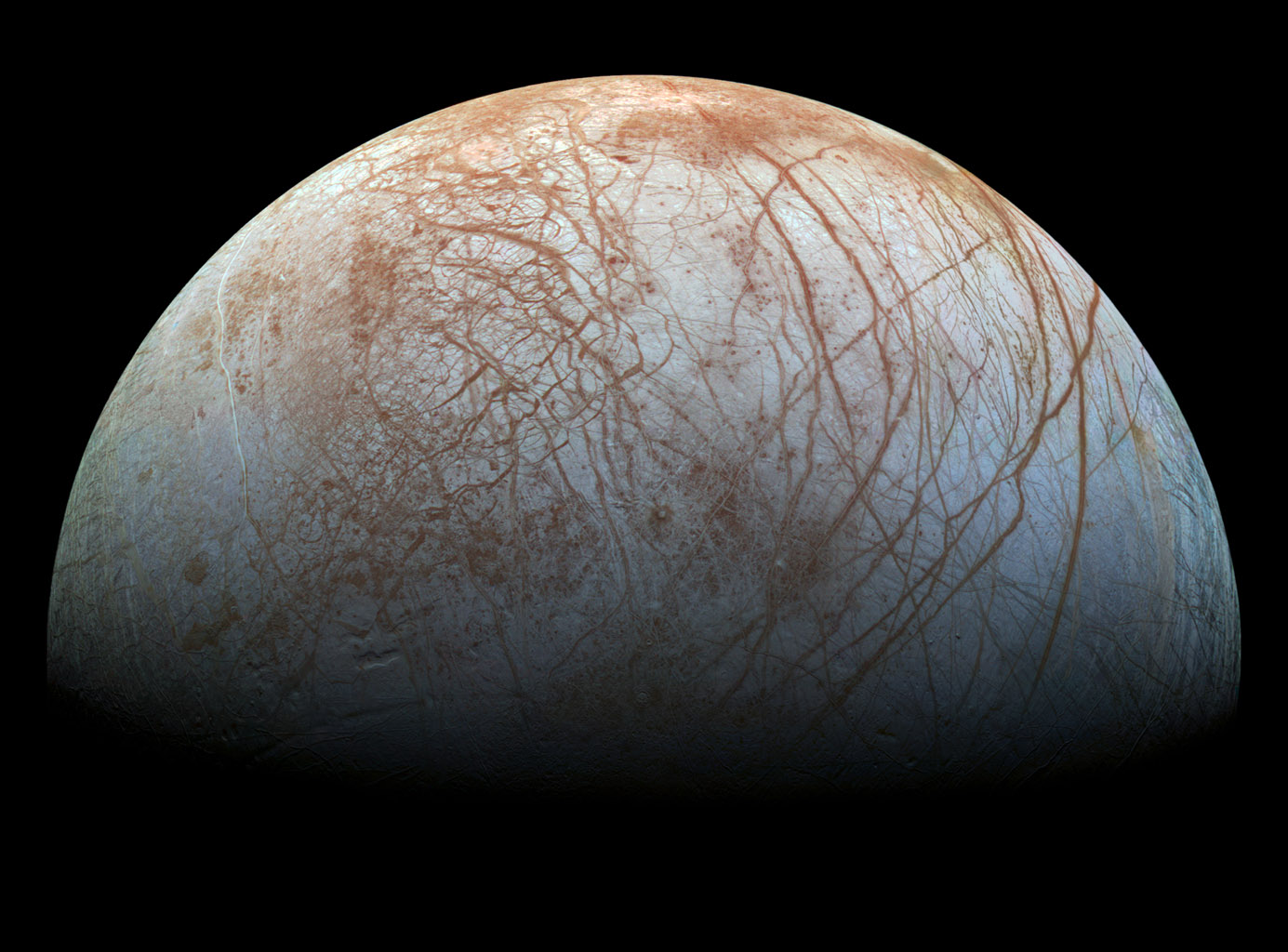 http://www.space.com/27854-jupiter-moon ... photo.html http://www.space.com/27854-jupiter-moon ... photo.html
|

 Posts:
Posts: 51957
 Posted: Posted: Fri Nov 28, 2014 8:57 am
$1: 'Meteoric smoke': Comet siding spring could alter Mars chemistry permanently Feeling lucky? Events such as the Comet Siding Spring approach by Mars in October only happen about once every eight million years, according to NASA. And after we were treated to spectacular views from the agency's spacecraft, we now have fresh pictures this month from an Indian mission. Also, NASA has released science results suggesting that the chemistry of Mars' atmosphere could be changed forever from the close encounter. "The image in the center shows a streak … radiating out of the comet's nucleus (out of frame), possibly indicating the jet from [the] comet's nucleus," the Indian Science Research Organisation wrote of the above image sequence on its Facebook mission page. "Usually jets represent outgassing activity from [the] vents of the comet-nucleus, releasing dust and ice crystals. The outgassing activity gradually increases as the comet moves closer to the Sun." The comet's dust likely produced a meteor shower or meteor storm when particles from it crashed into the upper atmosphere, which "literally changed the chemistry," added Jim Green, director of NASA's planetary science division, in a recent discussion highlighted on an agency blog.  http://phys.org/news/2014-11-meteoric-c ... istry.html
|

 Posts:
Posts: 13404
 Posted: Posted: Fri Nov 28, 2014 5:26 pm
These comet thingies are really terraforming devices launched 5 billion years ago by an extremely ancient ad advanced civilization who wanted to seed the galaxy with life.
|

 Posts:
Posts: 51957
 Posted: Posted: Tue Dec 02, 2014 8:31 am
$1: NASA Prepares To Test New Spacecraft (That You've Likely Never Heard Of)NASA is about to launch a new spaceship into orbit, and Mallory Loe has never heard of it. "I mean, technically, NASA doesn't have another spaceship, do they?" she asks incredulously during a visit to the Smithsonian National Air and Space Museum in Washington, D.C. She's hardly the only one who doesn't know about this new spacecraft. In fact, none of a half-dozen tourists NPR interviewed in the museum's lobby was aware of the Orion spaceship. On Thursday, the unmanned Orion test vehicle is set to be launched into space aboard a commercial rocket. It will orbit Earth twice, traveling 3,600 miles away from the planet on its second lap. Then it will re-enter the atmosphere and splash into the Pacific Ocean. It's designed for deep space, but Orion's first mission will be back to the neighborhood of the moon. The plan is to have a robot capture a small asteroid and drag it back to lunar orbit. Then Orion will carry up to four astronauts to meet it. It's all supposed to happen in the 2020s, though some say the mission is too complicated and not much of an advance. NASA Administrator Charles Bolden isn't surprised that nobody has heard about Orion. "Back in March of 1969, if you asked somebody about America's space program, they may have said, 'I think we've got this Apollo thing,' or something like that," he says. But four months later, after Neil Armstrong and Buzz Aldrin had landed on the moon, you'd be hard-pressed to find anyone who didn't know about it. "That's just the nature of the human beast," he says. Bolden hopes Thursday's test will be a similar wake-up call for Americans. Orion is very different from the space shuttle, which retired in 2011. The shuttle was shaped like a plane and could glide back to earth and land on a runway. It looked cool but had some serious limitations. "Winged vehicles are very, very difficult to design and build and operate," he says. The problems are even worse when returning from beyond low-earth orbit. On the way back from deep space, spacecraft are moving fast. All of that speed generates heat as a craft hits the atmosphere. To survive the re-entry, a spacecraft needs to be shaped in a way that's simple and tough. "I am told by all my aerodynamics friends and my rocket friends that the conical shape is the best shape for us," Bolden says. And that's why, on the outside at least, the new Orion looks almost exactly like the old Apollo capsule sitting in the Smithsonian. The Apollo 11 capsule that carried Armstrong, Aldrin and Mike Collins to the moon is gray, about the size of a midsize car, and has a cramped-looking interior. "To me, personally, it's amazing that three people could fit in there and stay in there for a week or so to get over to the moon and back," says Marcia Smith, the editor of SpacePolicyOnline.com. She still remembers those Apollo missions to the moon. "Apollo evokes, for me, the excitement of exploring new worlds," she says.    http://www.npr.org/blogs/thetwo-way/201 ... r-heard-of
|

 Posts:
Posts: 13404
 Posted: Posted: Fri Dec 05, 2014 5:26 pm
I was thinking while driving in after the successful launch this morning that NASA should be recruiting very short, small people for their manned mission to Mars. No, I'm not trying to be a smart-ass. They should find people say, in the four foot tall range who are "normal" that is, do not have malfunctioning pituitary glands. There should be people like that on the bell curve.
Anyway, "space" in that spacecraft will be at a real premium during such a long voyage. Smaller people probably use proportionally less of the essentials of life ... water, air and perhaps food. That will save weight and stress on recycling systems. Shorter people will be able to perform everything that taller ones would. You shouldn't need tall or powerful physiologies on such a voyage but in the Martian gravity field, even the slightest human would be a strong man/woman.
It ain't sexy and the "Right Stuff" fantasies don't go with it but the future of deep space voyaging might just be very much smaller human beings.
|
 
|
Page 63 of 237
|
[ 3542 posts ] |
Who is online |
Users browsing this forum: No registered users and 1 guest |

|
|

